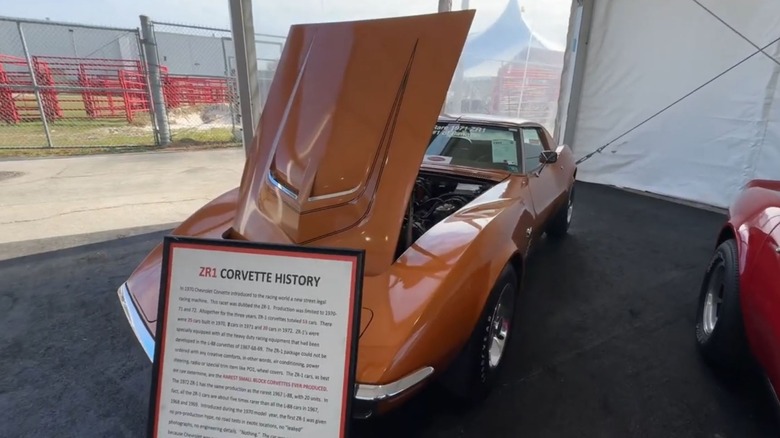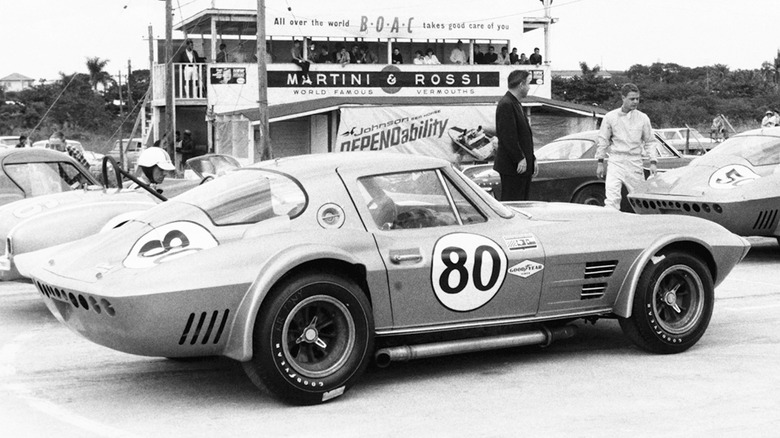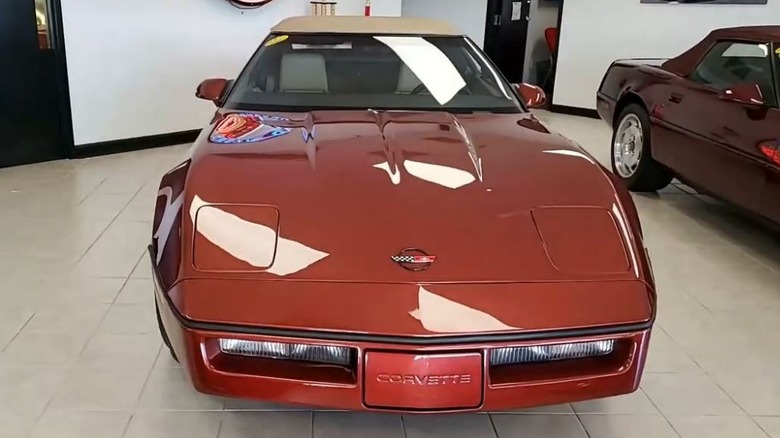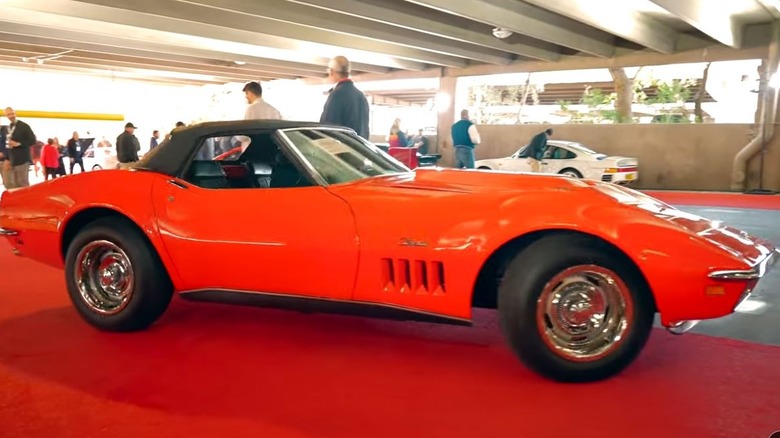5 Of The Rarest Corvettes Ever Made By Chevrolet
For 72 years, Chevrolet has been building the Corvette, which has earned its moniker of America's Sports Car in the process. The definition of an automotive icon, the Corvette has had its ups and downs over the decades, but overall, it remains a resounding success. As of 2019, Chevy has built over 1.6 million of its famous sports car over seven generations, with the eighth series currently tallying up even more sales.
As far as Chevy is concerned, every single one of those million-plus Corvettes is special, but when it comes to rarity, there are a choice few that stand out. Sure, the first year of Corvette production saw only 300 models roll off the assembly line, and given how important these cars are in the Corvette's history, those 300 are desirable and relatively rare.
Legendary nameplates like ZR1 and Grand Sport will be familiar to some, and certainly modern marvels like the C8 ZR1X are exciting, but when it comes to rarity, we're looking strictly at the number of models built, ordered from most to least. Fun fact: The rarest Corvette in history is a plain Jane base-model from the fourth generation, a period during which more than 358,000 Corvettes were produced.
1971 Corvette ZR1
The first time Chevrolet applied the ZR1 name to the Corvette was during the third-generation, or C3, production. Visual giveaways were few aside from an LT-1 logo on the domed hood, which denoted these Corvettes as potential members of the exclusive ZR1 club. The LT-1 was the name given to the special 350 cubic inch V8 that Chevy offered at the time as a standalone option for $484.
In 1970, the automaker had planned to replace the 427 L88 V8 with the 454 LS7, but that engine never materialized. However, the Camaro Z/28 featured the LT-1, a specialized 350 V8 engine with higher compression, a solid-lifter camshaft, and a factory rating of 370 horsepower. For reference, the base Corvette that year made 270 hp. The ZR1 package bundled the LT-1 engine with a host of chassis upgrades aimed at road racing for an $1,010. On the drivetrain front, features included a lightweight flywheel, a Muncie M22 four-speed manual transmission, an aluminum driveshaft, and a Positraction rear end.
Suspension enhancements included the F41 package with a heavy-duty front sway bar, seven-leaf rear springs, and beefed-up dampers and rear spindle struts. Chevy also deleted the air conditioning, power windows, steering, radio, and alarm system in the name of weight savings. All told, this specialty 1971 ZR1 package was as rare as it was impressive, with only eight models built out of nearly 22,000 C3s made that year.
1963 Corvette Grand Sport
During the 1960s, Detroit's Big Three automakers had an agreement with the American Manufacturers Association to abstain from factory-backed racing programs. But that didn't stop determined engineers like Zora Arkus-Duntov from trying to skirt this rule. Considered the father of the Corvette, Arkus-Duntov was at the time busy making Chevy's sports car faster. Coming off the 360-hp Corvette Z06, he began the 1963 Grand Sport project in secret.
The goal was to produce a small run of five lightweight aluminum racing Corvettes, designed with an eye toward Sebring and Le Mans, to sell to private teams in a bid to get General Motors brass excited about competitive Corvettes. These proof-of-concept cars featured wild bodywork with a louvered and ventilated hood, vented front fenders, side-exit exhaust pipes, and rear fender air intakes. Aluminum-intensive construction combined with a single layer of fiberglass for the body helped the Grand Sport shave 93 pounds compared to a stock 1963 Corvette.
Then there was the 377 cubic inch V8 under that hood, which, at 550 hp, produced a fairly shocking 300 more horsepower than a base Vette of that year. Zora's vision saw early success as the Grand Sports did beat Shelby's Cobras at the 1963 Nassau Grand Prix. Unfortunately, GM chose to stick by its racing ban agreement and pulled the plug on the covert program. So just five examples of the 1963 Corvette Grand Sport were ever made, making them very hard to come by. However, there is always the Superformance Corvette Grand Sport replica route for those in the market.
1986 Copper Metallic Corvette
The fourth-generation C4 Corvette may not swim in praise like most other Corvette generations, particularly garden-variety base models. Part of this can be chalked up to relatively tame specs. For 1986, the Corvette offered a 5.7-liter V8 with 230 horsepower at 4,000 rpm and 330 lb-ft of torque at 3,200 rpm and the option of four-speed automatic or manual transmissions. Towards the end of production, output was increased with a new LT1 engine, but today, early C4s are a relatively affordable entry point into the Corvette community. A 1984 coupe with 30,000 miles recently sold for just $9,600, for example.
Given the high volume of this long-running generation, more than 350,000 were built, which is less surprising. However, there is one particular C4 configuration that has gone on to become one of the rarest Corvettes ever made. During the 1986 model year, Chevy rolled out a new Copper Metallic paint color for the Corvette.
For reasons unknown, the take rate was extremely limited as just four examples were built with this finish that year. By 1987, the look picked up a bit of steam with 87 Copper Metallic Corvettes sold. But by then, the unusual shade was pulled from production as Chevrolet struggled to solve issues with the paint adhering to the body panels. So, if Copper Metallic floats your boat, and you can find one, these may be one of the more attainable rare Corvettes out there.
1969 Corvette ZL1
In recent memory, Chevrolet's ZL1 brand was applied to its track-attack Camaro variant. But in 1969, it was used to denote one of the most ferocious Corvettes ever built. It was just a year into C3 production, a time when famed racer Bruce McLaren worked closely with GM on engine builds for his race cars. It was a partnership that worked as McLaren won 32 out of 37 races in the SCCA Canadian-American (Can-Am) Challenge Cup Series between 1968 and 1971.
Chevy did make the ZL1 engine available for special order to anyone, but it was not advertised, and required an array of upgrades to obtain. That included the F41 suspension package, G81 Positraction rear-end, J56 heavy-duty brakes, and K66 transistorized ignition. Air-conditioning and a radio were not available, and all told, the ZL1 configuration cost nearly as much as a base 1969 Corvette. Much of that has to do with the engine itself. An all-aluminum, dry-sump lubricated 427 cubic-inch V8, it came with a factory rating of 430 hp, but was later producing as much as 585 horsepower.
The C3 Corvette had the longest production span of any generation at 15 years. Cars were built across the end of the muscle car era, through the malaise era, and into the 1980s, with more than 540,000 units moved. Making the two units of the 1969 Corvette ZL1, not to be confused with the ZR2, easily the rarest of all third-generation Corvettes.
1983 Corvette
The very rarest Chevy Corvette ever made has no exciting designations. It was not built to dominate any tracks and will not set any performance records. However, this car comes from a model year that saw exactly zero Corvette sales and is considered the forebear of all Corvette generations that have followed. It is the 1983 Corvette, specifically a base model used to fine-tune the launch of the C4 series.
It had stablemates that were also built as part of Chevy's plan to perfect the C4. The story goes that GM halted sales of the Corvette in 1983 because California had just changed its emissions requirements. As a result, Chevy required more time to get its all-new Corvette ready, and by the time it did so, just a single Corvette made in 1983 was left standing. The others were destroyed, and it is thought that this example was deliberately hidden away for posterity.
Later found in the factory parking lot, GM brought it back inside for a new stars-and-stripes paint job and 16-inch wheels from the 1984 model year. Ultimately, however, the single 1983 model was donated to the National Corvette Museum, where it was restored to its original white finish with the 15-inch wheels Chevy initially planned to fit to the C4. Along with its incredible rarity, this earliest fourth-gen Corvette comes from the series that pioneered a general Corvette design that remained in place, with regular updates, through the end of C7 production.





